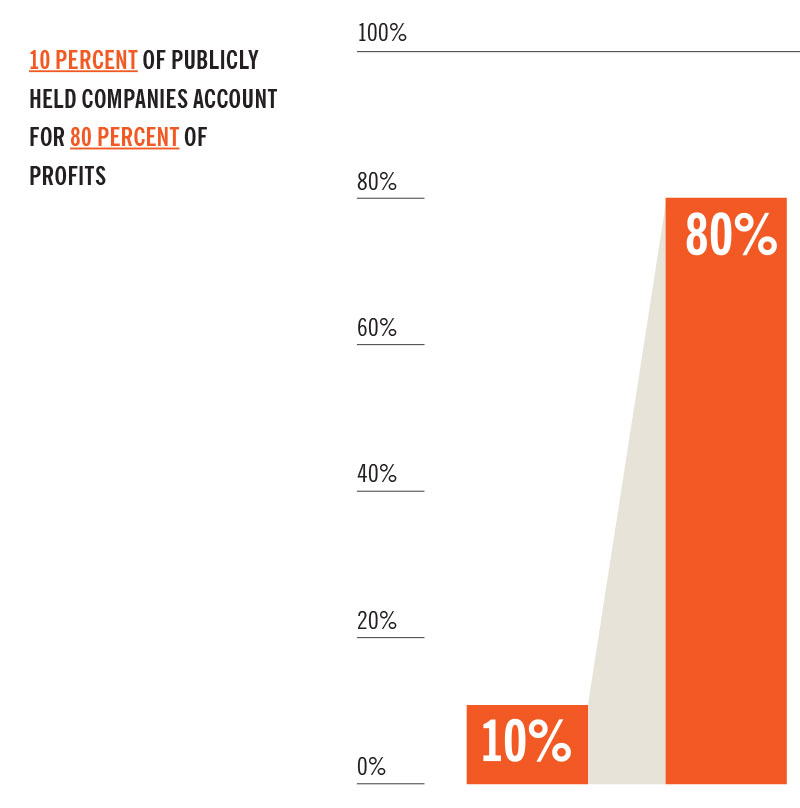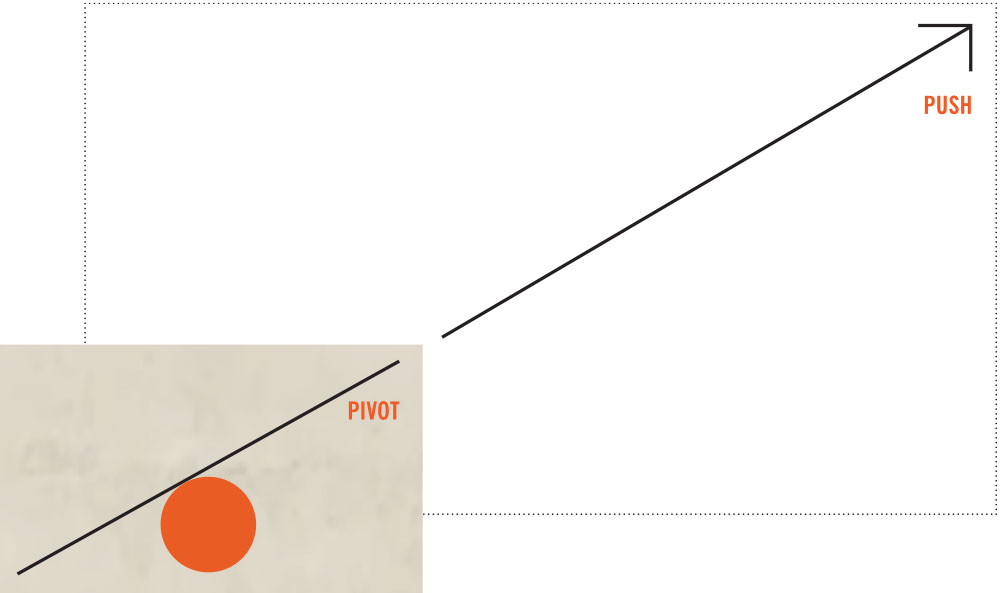Over three-quarters of businesses are undergoing some form of transformation, but under half of those businesses say they are on track to complete their effort.1 These big multi-year transformation efforts apply new technology to traditional business problems but are increasingly complex and often fail to produce planned results. Transformation doesn’t need to be a failure. Superstar companies have figured out how to scale big and create repeated transformation wins with the Pivot-Push Strategy.
Clients have asked me for years what they need for implementation — more people or more vendors or more of whatever — to get the job done with a business transformation. But the secret to a successful transformation is not more. The answer to a successful transformation is to start by doing less, and the best examples come from a group of businesses known as Superstars.
Superstar businesses are a small group. One study1 found that only 10 percent of publicly held companies account for 80 percent of profits! With many companies fighting for market share, with significant volatility around the world, and with an increased need to modernize, it is no surprise that only a small subset of companies can reliably capture substantial amounts of profit.

Not only do Superstars achieve results today, but they structure themselves for the future. They plan for scale. Scale forces us to think beyond this quarter, or even this year, and reminds us that business is an infinite game. Scale reminds us that reducing costs, improving customer experience, or growing revenue can be targeted today; but those need to be ever-expanding tomorrow. Counterintuitively, Superstars dominate in this ability to start small and then scale big for the long term.
Business leaders have a considerable task, yet a colossal opportunity, ahead of them. Leaders have never had more tools at their disposal, from innovation and technology to relevant benchmarks and change management.
So, how do leaders start small and then go big? How do they capture this opportunity and leverage the right tools? How do they scale? They implement the Pivot-Push Strategy.
PIVOT.
Superstars exploit a single business area where outsize results can be created. They don’t look for a big bet on a huge market; they look for a big bet in a nascent market, product, or even department. Failing to adapt your organization to new environments or reusing outdated playbooks can be prevented by finding the pivot point in your company. Figure out how you can obtain leverage and exploit that leverage. A word of warning: there are a lot of shiny objects, so it is essential to say no to things that look like revenue in the short term but are not scalable and are just chaotic opportunism.
THEN PUSH.
Superstars take the early wins and convert them into organizational momentum. When they build momentum with people and systems, they create the capability to accomplish even more significant amounts of change. Momentum building does not need to be boring, and it shouldn’t be. The push can be fun and a celebration of the positive behaviors and quantifiable wins that make business change stick. One word of warning: high turnover slows down momentum, so incenting and retaining key personnel is key to maintaining transformation momentum and to pushing for even greater gains.
Superstars apply the Pivot-Push Strategy in many areas. Here are three key areas of the Pivot-Push in action:

1. ORGANIZATIONAL RESTRUCTURING
PIVOT: Build a business partner role in your department. While you may have an opportunity for a complete reorganization, a business partnership is starting small, and an entire department reorganization is too big of a start. Business partners are popular across HR, IT, and other departments because their job focuses on creating a critical consulting role. This role can flex between administrative matters and strategic matters and creates a significant point of leverage for operational improvements.
THEN PUSH: Superstars create understanding between departments with business partners, so when it comes time for a push, you already have a clear win. Then, when you restructure, the organization already sees the benefit of defining additional roles. The benefit of the full re-structure is that you can create wins across many different teams and break down silos that have existed for too long. The restructuring becomes positive energy to redefine interaction models, fix spans and layers, and then move toward a more customer-centric organization.
2. CUSTOMER EXPERIENCE
Pivot: Create your customer experience journey map. While it may be in vogue to create a center of excellence around innovation or agile techniques, full-blown agile transformation is not starting small. Customer experience journey maps create a shared understanding across multiple teams. The simple act of understanding the entire customer journey from marketing awareness to finance cash collection is incredibly powerful to leverage for all process improvements.
Then Push: Superstars drive a customer-first model within all their operational processes. They can only create this push because they’ve built a common understanding across departments for the customer pain points and “jobs to be done.” The benefit of a customer-focused operational improvement is that significant wins can each be defined, prioritized, and delivered with the leverage of the customer experience journey map. These operational process improvements not only improve your customer experience, but they create much-needed wins toward transformation.
Scale forces us to think beyond this quarter, or even this year, and reminds us that business is an infinite game.
3. BUSINESS TRANSFORMATION
Pivot: Implement a targeted digital transformation project. While you may want to go for a large-scale change, creating a proof point is necessary before going big. Leverage and combine the outside-in views of technology vendors with the deep knowledge of your internal team. Digital transformation can be targeted around a mobile application, business intelligence function, or real-time dashboard for manually reported metrics. In each case, external support will help accelerate the pivot.
Then Push: Superstars have the capability to deliver a full business transformation. By leveraging smaller digital transformation initiatives and anchoring on competitive advantage, leaders are exceptional at delivering business transformation results across the entire enterprise. These leaders understand that measuring and achieving multiple transformation goals is necessary to drive increased momentum and set up the eventual success of subsequent large-scale transformations. Leaders leverage this momentum around revenue, cost, and customer experience improvements to drive ever-increasing levels of growth.
Superstars find the leverage with a pivot and then create momentum with a push. You can too.
Source:
- McKinsey Study
